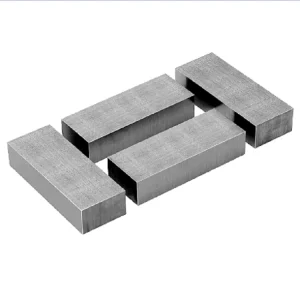
Introduction
Overview of Transformer Laminations
Transformer laminations are thin sheets of electrical steel used in the cores of transformers. These laminations are crucial for improving the efficiency and performance of transformers by reducing energy losses.
Importance in Electrical Engineering
The use of high-quality laminations is essential in modern electrical engineering, contributing to the efficiency, reliability, and longevity of transformers.
What Are Transformer Laminations?
Definition and Basic Structure
Transformer laminations are typically made from silicon steel and are used to construct the core of transformers. They are stacked together to form a cohesive structure that supports the transformer’s magnetic flux.
Materials Used in Laminations
Common materials include silicon steel, amorphous steel, and other advanced alloys, each chosen for their magnetic properties and ability to minimize energy losses.
Role of Transformer Laminations
Reducing Core Losses
Laminations play a crucial role in reducing core losses in transformers. Core losses primarily consist of hysteresis and eddy current losses. These losses occur due to the alternating magnetic field within the transformer core. Laminations address this issue by using thin, insulated sheets of electrical steel. The insulation between each sheet limits the flow of eddy currents, which are small circulating currents induced in the core material. By restricting these currents, laminations significantly reduce energy wastage. Additionally, the thinness of the laminations helps optimize the magnetic flux within the core. This careful design ensures that the magnetic energy is efficiently channeled, minimizing overall losses and enhancing performance.
Enhancing Transformer Efficiency
By minimizing energy losses, laminations greatly enhance the overall efficiency of transformers. This improvement is critical for both economic and operational reasons. Efficient transformers require less electrical energy to operate, leading to lower electricity bills and operational costs. Enhanced efficiency also means that less energy is wasted as heat, which contributes to a cooler operating environment. This reduction in wasted energy directly translates to better performance and reliability. Moreover, efficient transformers are capable of handling higher loads more effectively, ensuring stable and consistent energy delivery. This is particularly important in high-demand scenarios, where maintaining efficiency can significantly impact performance and service continuity.
Impact on Transformer Performance
The quality and configuration of laminations directly affect the performance of transformers. High-quality laminations ensure that the magnetic properties of the core are optimal, reducing energy losses and improving efficiency. Proper configuration and alignment of laminations also play a critical role in heat dissipation. Well-aligned laminations provide better pathways for heat to escape, preventing overheating and prolonging the lifespan of the transformer. Furthermore, the precise arrangement of laminations helps in reducing operational noise. Transformers with well-configured laminations operate more quietly, which is beneficial in residential and urban settings. Overall, the meticulous design and implementation of laminations have a profound impact on the transformer’s energy efficiency, heat management, and noise reduction. This ensures that transformers perform reliably and efficiently in various applications.
Types
Grain-Oriented Silicon Steel (GOES)
GOES laminations are specially processed to align the grain structure, which enhances magnetic properties and reduces losses in the transformer core.
Non-Grain-Oriented Silicon Steel (NGOES)
NGOES laminations are used where multi-directional magnetic properties are required, offering flexibility in transformer design.
Amorphous Metal Laminations
These laminations provide excellent magnetic properties and very low core losses, making them ideal for high-efficiency transformers.
Applications
Laminations are essential in large power transformers used for utility grids. In these applications, efficiency and reliability are critical. Power transformers handle significant amounts of electrical energy, making it vital to minimize losses. High-quality laminations reduce core losses, ensuring that the transformer operates efficiently. This efficiency translates to lower operational costs for utility companies. Additionally, reliable transformers help in maintaining a stable electricity supply. Consistent performance is crucial for preventing outages and ensuring continuous service. The use of advanced materials in laminations also enhances the durability of power transformers, allowing them to function effectively for many years. This long lifespan is vital for infrastructure that supports entire communities and industries.
Smaller distribution transformers also rely heavily on high-quality laminations. These transformers are used in residential and commercial settings. Efficient energy transfer is a primary concern in these applications. Laminations help achieve this by minimizing energy losses. As a result, homes and businesses receive electricity more efficiently. This efficiency helps in reducing electricity bills and energy wastage. Distribution transformers must operate quietly and reliably in urban environments. Properly designed laminations contribute to reduced noise levels, making them suitable for installation in populated areas. The durability of the laminations ensures that these transformers can handle daily fluctuations in energy demand without frequent maintenance. This reliability is crucial for maintaining uninterrupted electrical service in homes and businesses.
Specialty Transformers
Specialty transformers, such as those used in medical or industrial applications, benefit greatly from customized lamination designs. These transformers often have specific performance requirements. For example, medical transformers need to provide stable and precise voltage levels for sensitive equipment. Customized laminations help in achieving the necessary precision and efficiency. Industrial transformers might require high resistance to harsh environmental conditions. Specialized lamination materials and designs can provide the needed robustness and reliability. By tailoring the laminations to the specific needs of the application, manufacturers can ensure optimal performance. This customization enhances the overall efficiency and lifespan of specialty transformers, making them a reliable choice for critical applications.